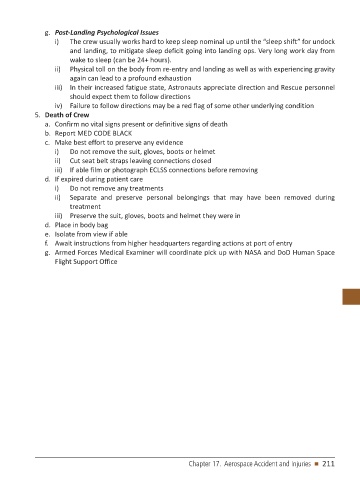Page 213 - PJ MED OPS Handbook 8th Ed
P. 213
g. Post-Landing Psychological Issues
i) The crew usually works hard to keep sleep nominal up until the “sleep shift” for undock
and landing, to mitigate sleep deficit going into landing ops. Very long work day from
wake to sleep (can be 24+ hours).
ii) Physical toll on the body from re-entry and landing as well as with experiencing gravity
again can lead to a profound exhaustion
iii) In their increased fatigue state, Astronauts appreciate direction and Rescue personnel
should expect them to follow directions
iv) Failure to follow directions may be a red flag of some other underlying condition
5. Death of Crew
a. Confirm no vital signs present or definitive signs of death
b. Report MED CODE BLACK
c. Make best effort to preserve any evidence
i) Do not remove the suit, gloves, boots or helmet
ii) Cut seat belt straps leaving connections closed
iii) If able film or photograph ECLSS connections before removing
d. If expired during patient care
i) Do not remove any treatments
ii) Separate and preserve personal belongings that may have been removed during
treatment
iii) Preserve the suit, gloves, boots and helmet they were in
d. Place in body bag
e. Isolate from view if able
f. Await instructions from higher headquarters regarding actions at port of entry
g. Armed Forces Medical Examiner will coordinate pick up with NASA and DoD Human Space
Flight Support Office
Chapter 17. Aerospace Accident and Injuries n 211

